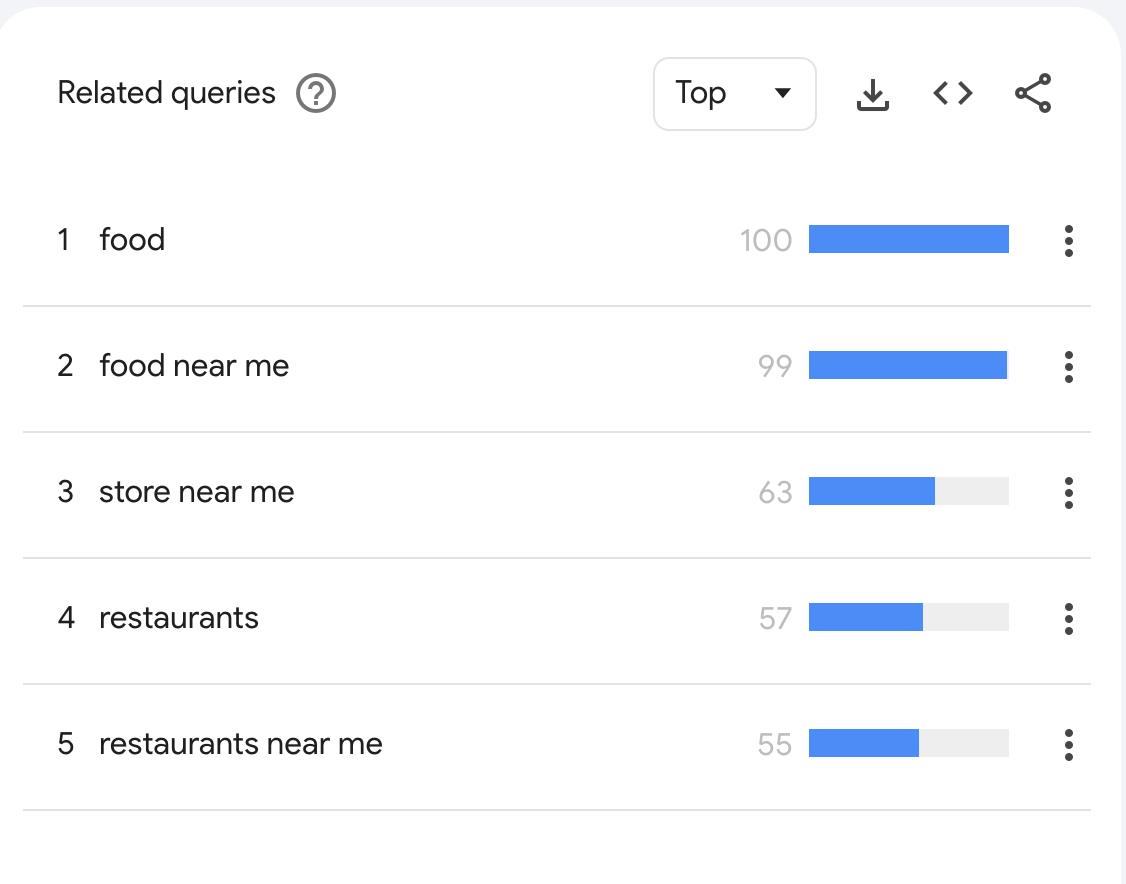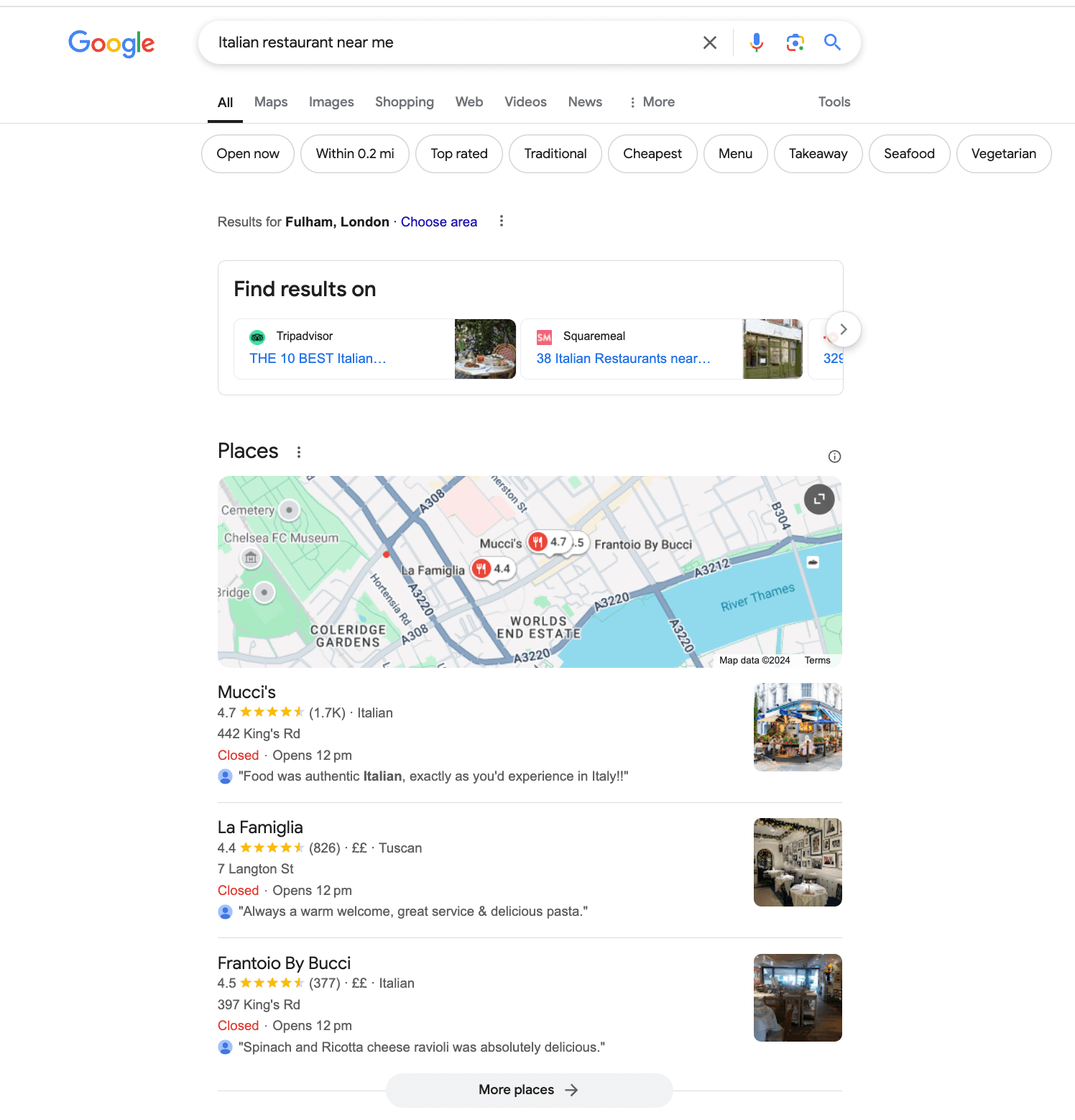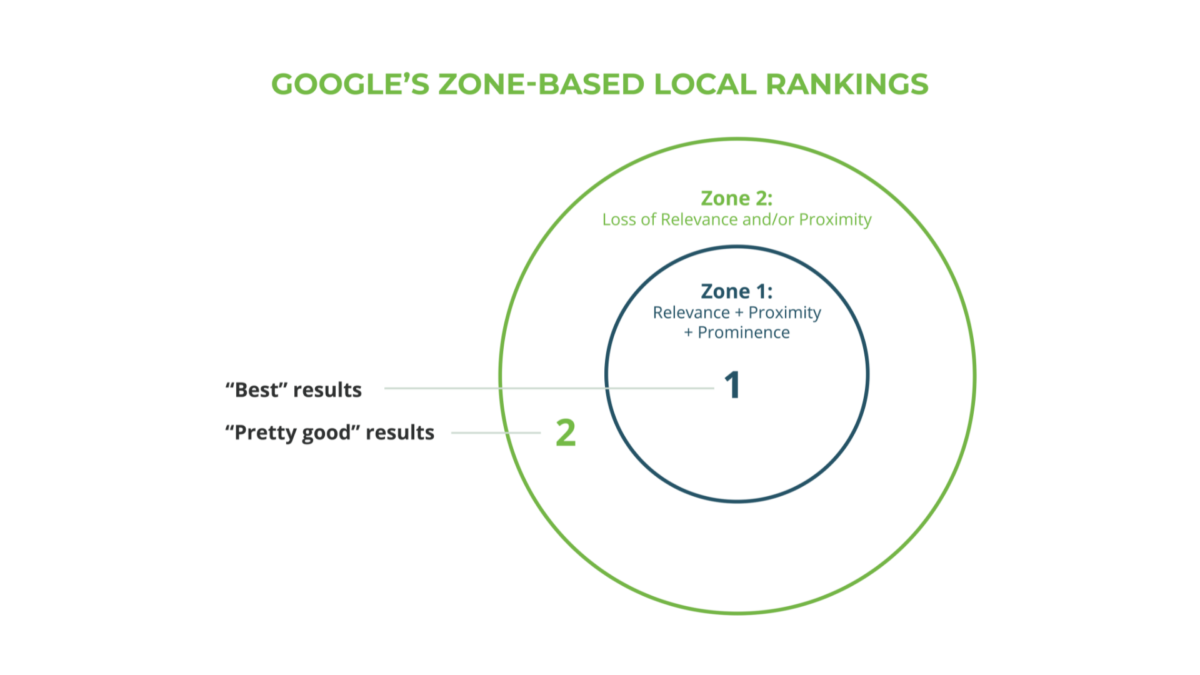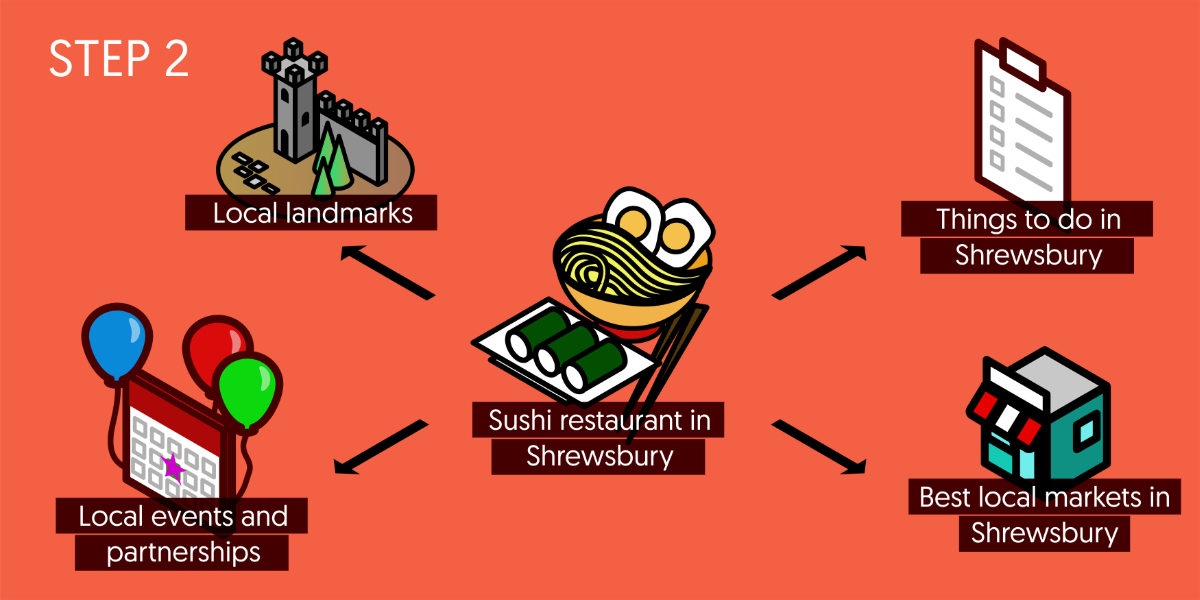With over 6.2 million “restaurants near me” searches happening every month—and that’s not even counting popular variations like “pizza near me”—the stakes for local visibility have never been higher.
In today’s competitive dining landscape, if your restaurant isn’t showing up for these booking-intent “near me” searches on Google, you’re missing out on a flood of hungry customers ready to make a reservation.
Growth in 'Near Me' Searches :
Near me” searches have skyrocketed in recent years.
Just take a look at these eye-popping statistics.

Restaurants dominate "near me' searches
Google Trends reveal that food and restaurant searches consistently dominate “near me” queries worldwide.
For restaurant owners, this is a huge opportunity to drive more bookings and increase visibility.

Google 3-Pack - 'The Money Zone'
The Google 3-Pack is where top local search results appear, driving the most traffic and bookings.
It’s called the “money zone” for a reason: ranking here can significantly impact your bottom line.
But here’s the game-changer: 
Google now treats “near me” as a proximity indicator, not just a keyword phrase.
This means simply stuffing “near me” into your content won’t work anymore.
To rank in this coveted 3-Pack, restaurants need to focus on genuine local optimisation.
Why Google’s “Near Me” Searches Are All About Proximity
Google analyses three main factors for local search queries.

Relevance: How well your Google Business Profile matches what someone is searching for.
Proximity: The distance between your restaurant and the searcher’s current location.
Prominence: How well-known your restaurant is and the information available about you online.
The impact of optimising for these factors is huge.
If you want to secure a spot on Google's 3-Pack and drive bookings from diners who are ready to eat, you need to adapt.
Keep your business information accurate, build local trust, and optimise your online presence.
What is Local SEO for Restaurants?

Local SEO ensures your restaurant shows up when hungry customers search nearby.
It’s about boosting your visibility in local search results for phrases like “best sushi near me” or “steakhouse open now.”
In today’s world, where local searches drive instant decisions, nailing your local SEO is essential.
Key Aspects of a Winning Local SEO Strategy for Restaurants:
- Creating a Google Business Profile (GBP): Your digital storefront that helps hungry diners find you fast.
- Using Local Keywords in Your Content: Think phrases like “best brunch in [City]” to capture local search traffic.
- Being Consistent with NAP Details: Your Name, Address, and Phone Number should be identical everywhere—no exceptions.
- Linking with Local Directories: Make sure your restaurant is listed on platforms like Yelp, TripAdvisor, and local food blogs.
- Encouraging Reviews and Managing Your Online Reputation: Positive reviews boost your credibility and visibility.
- Creating Local Content: Blog about community events or partnerships to show you’re part of the neighborhood.
The Shift in “Near Me” Optimisation
For years, restaurants could game the system by cramming “near me” into page titles and headings.
It worked—until Google’s latest update.
Now, “near me” is seen as a proximity indicator, not just a keyword.
Instead of relying on keyword stuffing, you need to focus on genuine local optimisation.
The good news?
This shift opens up new opportunities to leverage proximity-based searches.
The key is understanding and adapting to Google’s Proximity Update.
The New Way to Optimise Your Restaurant for 'Near Me' Searches
Step 1: Claim and Verify Your Restaurant on Essential Directories

Start by claiming and verifying your restaurant on key directories:
- Google My Business: Your top priority for local SEO.
- Bing Places: Still relevant, with a sizeable user base.
- Yelp: A major player for restaurant reviews.
- Apple Maps: Critical for iPhone users.
- Facebook: Keep it updated with hours and menu links.
- Foursquare: Useful for location-based check-ins.
- TripAdvisor: Essential for attracting tourists and locals.
Action Tip: Double-check your Name, Address, and Phone Number (NAP) for consistency across all platforms.
Step 2: Create Local Content That Captures Attention

Use local lingo and details to make your website stand out.
Here’s how:
- Build Location Pages: Create a dedicated page for each neighbourhood or city you serve, including address, hours, and menu highlights.
- Use Location-Based Keywords: Sprinkle in phrases like “best sushi in Soho” or “Sunday roast in Yorkshire” authentically.
- Highlight Local Landmarks or Events: Mention nearby attractions or events to show you’re part of the local scene.
Pro Tip: Here's what every location page needs.

Step 3: Make Use of Schema Markup (Your Web Designer Will Know How)
Schema markup adds extra info to your site, making it easier for Google to understand your restaurant.

Here’s why it matters:
- Enhance Search Listings: Show up with rich snippets like menu details and hours.
- Appear in the Knowledge Graph: Increase your chances of being featured prominently.
- Signal Accurate Location: Use coordinates to boost local search ranking.
How to Implement It: Let your web designer handle this. They can use a generation tool or a plugin to add schema markup easily. If you’re feeling lost, reach out—we’d be happy to help!
Step 4: Use Embedded Maps to Make Finding You Easy

Interactive maps on your website do more than show your location:
- Improved User Experience: Visitors can get directions without leaving your site.
- Boost Visibility: Embedded maps signal your exact location to Google.
- Direct Reservations: “Reserve with Google” lets customers book directly from the map.
How to Add It: Your web designer can embed the map using HTML. Need assistance? We’re here to help!
Step 5: Optimize Your On-Page Content

Location pages are the best place for your hours, schema markup, and maps:
- SEO-Rich Content: Use local keywords like “seafood restaurant in Bristol.”
- Geographically-Optimised Title Tags and Meta Descriptions: Clearly feature your services and city.
- Optimised Alt Text and Internal Links: Strengthen your SEO by describing images and linking related pages.
Pro Tip: Work with your web designer to ensure these pages are both user-friendly and SEO-optimised.
Step 6: Encourage Reviews and Build Trust

Getting reviews on your Google Business Profile is vital for visibility and credibility:
- Make It Easy: Add direct links for leaving reviews in emails and on your site.
- Highlight Review Value: Reviews are trust signals for Google and potential customers.
- Don’t Fear Negatives: A mix of positive and critical feedback can add authenticity.
Pro Tip: How to get more Google Restaurant Reviews
Step 7: Respond to All Reviews

Responding to reviews can be tough, but it’s a must.
Google values quick, thoughtful replies with local keywords.
And don’t forget to manage your reputation across multiple platforms, like TripAdvisor and Yelp.
Shameless Plug Alert: BFN-AI makes this task easy, generating personalized, SEO-friendly replies and keeping your brand voice consistent across platforms.

Step 8: Optimise for Voice Search to Boost 'Near Me' Visibility

Voice search is on the rise, and here’s how to capitalise on it:
- Use Natural Language: Write content that mimics how people talk.
- Focus on Long-Tail Keywords: Phrases like “best Sunday roast near me” work well.
- Implement FAQ Schema: This can get your restaurant featured in voice search results.
Examples with UK Locations:
- “Looking for a romantic dinner in Soho? Our Italian restaurant on Dean Street is perfect.”
- “Craving fish and chips in Brighton? We deliver to Hove and nearby areas.”
- “Searching for the best curry in Birmingham? Visit our spot in the Jewellery Quarter.”
Including specific geographic details enhances your content for voice search and local SEO.
Bottom Line: Your Best Shot at Ranking Your Restaurant for 'Near Me' Searches
Even with Google’s updates, your restaurant can still rank for high-intent “near me” searches.
Make sure your information is accurate, your local content is optimised, and your online presence is strong.
A well-rounded local SEO strategy will help you attract ready-to-book diners and boost your bottom line.
And remember, using the right tools—like BFN-AI—will make responding to reviews a breeze.